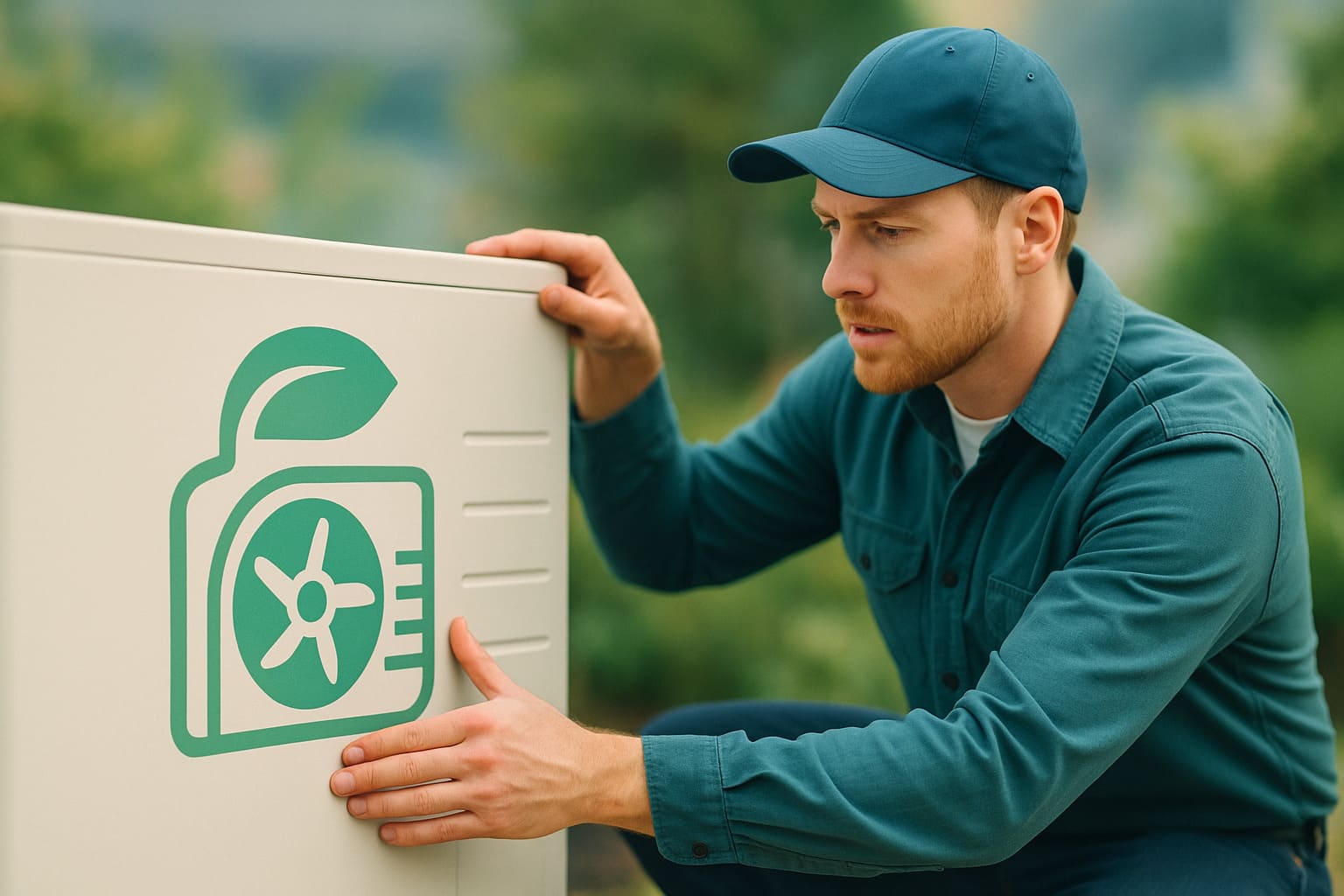Imagine coming home on a freezing winter night and stepping into a space that’s perfectly warm without the roar of a furnace or sky-high energy bills. You might wonder how your neighbor keeps their home so comfortable year-round with just one system. That’s the magic of a heat pump. If you’ve heard the term but aren’t quite sure what a heat pump is or how it works you’re not alone. Let’s uncover how this clever technology keeps your home cozy in winter and cool in summer.
What Is a Heat Pump?
A heat pump is a machine that makes your home warm in winter and cool in summer. Have you ever walked into a warm room after playing outside on a cold day? That warm air may come from a heat pump.
Heat pumps work like magic because they both heat and cool air in one system. Your friend might need a heater and an air conditioner. You just need your heat pump. Isn’t that interesting?
A heat pump moves heat instead of making it. It takes heat from the air outside, even when it feels cold to you, and brings this heat inside. When you want your house to feel cool, it takes heat from your house and moves it outside. So simple, right?
Heat pumps use less energy than many heaters or air conditioners. Have you ever seen your family worry about the power bill? A heat pump helps make that bill smaller.
Most heat pumps look like big boxes next to your house. Some sit up on walls or in your yard. If you have ever seen a big box with a fan spinning inside, it might be your heat pump at work.
How Does a Heat Pump Work?
A heat pump can keep your home warm in winter and cool in summer. It’s smart—one system does both jobs! Ever wonder how it does this by just moving heat instead of making it? Let’s break it down.
The Basic Principles of Heat Transfer
Heat moves from warm places to cold places. That’s nature. You know when you open the door on a cold day and the warm air rushes out? A heat pump flips the script. It pulls warmth from the chilly air outside—even when it feels freezing—and brings it into your home. This sounds wild, but it works, just like your fridge pulls warmth out to keep your food cool.
Why does this matter for you? If you like saving money and energy, heat pumps are your friend. They move heat using electricity, but it often takes less energy than making heat. The Coefficient of Performance, or COP, shows how much heat the pump moves for every bit of electricity used. A higher COP means you get more heat for your power.
Key Components of a Heat Pump System
You might have seen a heat pump outside a neighbor’s house. It looks like a big box with a fan. Inside and out, it uses a few key parts to move heat:
- Evaporator: This coil soaks up heat from the air or ground outside. Have you touched the back of your fridge when it’s running? That’s the same kind of process—pulling in warmth.
- Compressor: This part squeezes the gas in the system to make it hotter. It’s like pumping up a bike tire, where squeezing air makes it warm to the touch.
- Condenser: This part lets out the heat inside your home, making your rooms cozy when it’s cold outside.
- Expansion Valve: This piece cools the gas back down, so it’s ready to grab more heat and start the cycle again.
- Reversing Valve: This smart valve changes the flow of the system. When you want cool air, it flips everything. Now your heat pump takes warmth from your home and sends it outside.
Ever switched from heat to cool with a press of a button? That’s your heat pump at work, swapping what parts do which job. This makes life at home comfy year-round, and you use just one system for both. Pretty neat, right?
Types of Heat Pumps
Heat pumps come in a few kinds. Each type finds heat in a different place. Some use air. Some use ground. Some use water. Which one would fit your home best?
Air Source Heat Pumps
Air Source Heat Pumps pull heat from the air outside. Isn’t it neat that even cold air has heat inside it? These pumps work great in many homes. When you want to feel warm in winter, they grab heat from outdoors and move it inside. In summer, they do the reverse. Imagine a big quiet box sitting outside your house. You may have seen one in a yard or on a wall. This is the most common pump you’ll find. Kids often run by and feel the little breeze from its fan.
Ground Source (Geothermal) Heat Pumps
Ground source heat pumps find heat under your yard. The ground keeps a steady warmth, even in deep snow or hot sun. Long pipes go under the grass, hidden from sight. Warmth from the ground flows up the pipes. The pump then pushes it into your home. Have you ever dug a hole and felt the ground get warmer as you went down? That’s the same heat these pumps use. These kinds cost more at first, but they save more energy later. Big families who plan to stay for years sometimes pick this type.
Water Source Heat Pumps
Water Source Heat Pumps get heat from water. They use a pond, lake, or even a deep well. The pump moves heat from the water into your house. If you have a pond in your yard, did you ever wonder if it keeps the same temperature all year? That’s because water stores heat well. Not every home can use this type, but some with nearby water can. People who live next to lakes sometimes talk about how quiet these pumps are.
Picking a pump depends on where you live and what you want. What sounds right for your house?
Benefits and Drawbacks of Using a Heat Pump
Heat pumps bring many good things to your home. You get both heat and cool air from just one machine. Think about how nice it feels to walk into a warm room on a cold day or a cool room in the summer. You save energy too. A heat pump doesn’t make new heat. It moves heat from one place to another. This can use less electricity than old heaters. Families who switched to heat pumps noticed lighter bills at the end of the month. Some see their costs drop by up to half compared to electric heaters or old gas furnaces.
Heat pumps are gentle on the planet. They don’t burn fuel like gas or oil heaters. If your power comes from wind or solar, your home can run with very little pollution. Using a heat pump makes your carbon footprint smaller. That’s good for everyone. People often feel proud knowing they use less energy and help fight climate change.
Have you ever used a big noisy heater on a winter night? Heat pumps run quietly. You can listen for yourself. Most people only hear a soft hum, not a loud fan or clanking parts. This makes for a calm home, day or night.
Still, heat pumps come with some challenges. Have you lived where winters get super cold? When it’s below freezing, heat pumps might not warm the house as much. Some homes use a backup heater on the very coldest days. You might need to plan ahead for these days, so your home stays comfortable.
Starting with a heat pump costs more. Buying and putting it in often costs more than getting a regular heater, especially if you pick a large model or need extra pipes underground. Think about your budget before you buy. But, some families share stories that the monthly savings help cover the higher price as time goes by.
Running on electricity means a heat pump stops if the power goes out. Did your town ever lose power during a storm? When that happens, another plan, like a fireplace, can keep your house safe and warm.
In short, heat pumps give you warmth in winter, coolness in summer, savings on bills, and a cleaner industry. You get a quiet home, help the environment, and enjoy steady comfort. Will a heat pump fit your family’s needs? Only you know what matters most to your home.
Heat Pumps vs. Traditional Heating and Cooling Systems
Think about a cold night. Would you rather come home to a warm room right away, or wait while the heater wakes up? With a heat pump, your home feels cozy fast. But how do heat pumps stand out compared to old heating and cooling systems?
Heat pumps move heat. That means they take warmth from outside air or the ground and bring it into your house. On warm days, they do the opposite. They take heat from inside your home and toss it outside. It’s like a two-way street for comfort!
Traditional systems work differently. A furnace makes heat using gas or electricity. It burns fuel or uses lots of power—just to make you warm. An air conditioner cools the house by pushing out hot air. Both machines need lots of energy. You also have to take care of two systems. Fixing them can cost more over time.
Heat pumps are one machine that heats and cools. They use less energy. For example, if your old heater needs 2 units of electricity to make 2 units of heat, a heat pump can move 3 units of heat with only 1 unit of power. That means you save money. You see, a heat pump doesn’t work harder—just smarter.
Do you see fewer wires and pipes outside your neighbor’s house? They might use a heat pump. Many people say their bills go down after they switch. Some friends of mine tried it last year and stayed comfy all winter, even when snow covered the yard.
Here’s a look at some differences:
| Feature | Heat Pump | Traditional System |
|---|---|---|
| Heating + Cooling | Both in one | Uses two machines |
| Power Use | Less (moves heat) | More (makes heat) |
| Cost to Run | Lower | Higher |
| Energy Source | Electricity | Gas or electricity |
| Install/Repair | One system | Two systems |
| Green Choice | Yes (can use clean energy) | Often not |
Want to help the planet? Heat pumps can run on wind or solar energy from your power company. That means you’re not just saving money—you’re helping keep the air clean. What matters most to you: saving money, feeling good, or helping the Earth? Heat pumps make it easier to do all three.
Conclusion
Choosing the right heating and cooling system plays a big role in your home’s comfort and your monthly expenses. If you’re looking for a solution that’s efficient quiet and environmentally friendly a heat pump could be just what you need. Take some time to assess your home’s needs and your long-term goals before making a decision. Investing in the right system now can lead to years of reliable comfort and savings.

